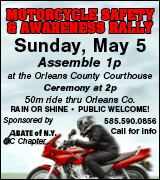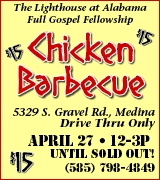‘I thought I was hurt. I thought I was definitely in trouble.’
“I thought I was hurt. I thought I was definitely in trouble.” – Deputy James DeFilipps on March 21 shootout
HOLLEY – Deputy James DeFilipps feels grateful to be alive. He knows a gun shot an inch lower on March 21 could have ended his life.
DeFilipps was the first police officer on scene when James Ellis wrecked his vehicle in a high-speed chase at about 3 a.m. on March 21. Police were pursuing Ellis after a 911 call that he had threatened an ex-girlfriend in Shelby with a gun.

Photos by Tom Rivers – This front yard on Route 31A is pictured on March 21 with the marks from the vehicle driven and crashed by James Ellis.
Ellis, 44, of Wyoming County, crashed his vehicle into a telephone pole on Route 31A in Clarendon at about 3 a.m. DeFilipps discovered the wreck in a neighbor’s front yard while looking for Ellis. When DeFilipps left his patrol car to search for Ellis, the suspect opened fire from a wooded area near the vehicle, Sheriff Scott Hess said during a March 21 press conference.
DeFilipps was hit twice in the chest. A bullet proof vest stopped the bullets, although he was badly bruised in the stomach from one shot. The deputy returned fire and fatally shot Ellis.
A grand jury reviewed the evidence and found DeFilipps was justified in the shooting.
DeFilipps is a 12-year member of the Sheriff’s Department. He started his career as a Holley police officer. He continues to live in Holley, where he grew up. His mother Marsha is the long-time Holley and Murray historian.
DeFilipps, 38, has been a member of the Holley Fire Department for 20 years. He is currently a fire commissioner for the Holley Joint Fire District.
He sat down for an interview in his home last week. His wife Marie also joined the conversation at the end. Both expressed relief that DeFilipps wasn’t more seriously injured. They also said the mourn the loss of Ellis’s life, especially for his immediate family.
Question: I wonder how that initial dispatch came over to you. It was 2:46 a.m. and the call was for the incident in Shelby. I know you were on the other end of the county.
Answer: I was in Murray. I was the lead person that night. It goes by years, by seniority of the shift. Josh Narburgh actually has 18 years but he transferred over. I had the lead position because there were no other sergeants on.

Deputy James DeFilipps is pictured with deputies Brian Larkin, left, and Kevin Colonna, who also responded to the March 21 incident with James Ellis. The deputies and other first responders were recognized during an April 22 County Legislature meeting.
Q: How many other deputies were on that night?
A: There was a deputy working on the west side, who was Kevin Colonna. There was a center deputy, who was Josh Narburgh. He was training Brian Larkin. There was technically four of us on for the county that night.
There was also a double troop car (state troopers).
Based on the original dispatch, I was headed that was as an extra support car, make sure everything goes OK. Soon into it, I don’t know how soon, they had seen the car leave and head east on 31A.
Q: There are people out at 3 in the morning that saw him?
A: Our patrol cars saw him. He came straight down 31A. Two of our county cars turned and were going after him. He was a lot faster than we were. He was driving a Grand Marquis and we had Tahoes.
Originally I made it to Riches Corners Road (in Albion) and saw his car. It looked like maybe he was pulling over or turning around. I’m not sure what he was doing. He was pretty slow on the side of the road. I started slowing down and turned around. As soon as he seen me, he took off again, eastbound.
I pursued after him but he was gone in a minute. I didn’t even turn on my (emergency) lights on. He was gone. I didn’t have my emergency lights on until after he crashed.
Q: Having multiple cars pursuing him, were you hoping he would just surrender and not have it escalate?
A: That’s what I was hoping. He had a gun. I was just back up, covering everybody to be safe. It is so rare to have a shooting out here.
Q: Even though it’s rare, is that potential always in the back of your head?
A: We all hope, especially myself, to go a career without ever having to be in a gun battle. You try.
Q: So you’re at Riches Corners, and he takes off.
A: He takes off and I go after him. Around Powerline Road I had lost sight of him. The Holley car had come up and made it to 237 and 31A, to see if he crossed through there. (The Holley officer) had got there just before I got to the intersection. He hadn’t seen him. I continued on. He was going a pretty good speed and Monroe County was notified to keep an eye out for him.
I come around the corner and had run over the powerlines that were involved in the accident scene.
There were powerlines down from where the pole snapped. I’m not sure because I was into the scene and it happened so fast and then I went on the ambulance. I drove through, I had hit the lines, made a quick decision to continue past and turned around. I radioed the other guys that ‘Hey, there’s wires down and there’s a wreck.’

This new telephone pole was put up by National Grid on March 21 at this location at a bend on Route 31A. James Ellis hit the previous pole, taking down the power lines. This photo was taken during the afternoon on March 21.
Q: So you’re the first guy on the scene by yourself?
A: The troop car I knew wasn’t far behind me. I had seen their lights in the Clarendon area.
Q: Could you tell the car driven by Ellis was in the neighbor’s lawn?
A: I hit the power lines and I made the decision to drive through to be safe. I could see the car up on the guy’s lawn. The doors are closed and looked like the air bag and he were in the vehicle. I go through the scene, try to make a safe distance to turn around and then put my spotlight on the vehicle.
He had a gun, and we had time. There is no reason to rush in and get hurt.
We have rifles. At that point I’m a safe distance away from the scene so I grab the rifle just in case. We can sling them on us and we still have our hands free. I get out of the car and I put my rifle on. I radio to those guys to be careful of the wires because they’re on the other end of the scene and they’re showing up. I get around to the passenger side of my car. I charge my weapon. That’s when shots start going off. I have no idea where they’re coming from. They are close.
Q: At that point how many officers are there?
A: All of our cars were there. The trooper car was there on the other side. We formed a triangle on the car.
Q: Did you drive up on the lawn?
A: No, we were still in the road. When I stopped in the road, my first thought is, ‘I got to block traffic.’ That’s when my lights came on, to stop traffic. They’re far enough back so they can approach and be safe. So they were all on scene because they were hearing the shots whizzing by them, the first rounds. I knew they were close but I couldn’t see.
We were focusing on the car. I don’t see him (Ellis) behind me. It was too close for comfort. I wanted better coverage. By the side of the road it was a little bit darker. It was away from the lights of my vehicle, maybe a little better coverage.
As I got by the side of the road, into the wood line, he had seen me first and I felt two shots to me. At that time I could see where he was and I returned fire.
At that point he went down. I backed up some. I knelt down. Radioed that he was down. Radioed that I had been hit. Radioed that we needed an ambulance to come on the South Holley Road side. Someone asked if suspect is down, and I said yes, suspect is down.
Those guys then ran right in. They ran in, they knew I was hit. They ran in and secured him, made sure the gun was away from him. He was kind of hunched over into a tree. They made sure he was safe and then they checked me.
They knew I was hit. Some of those guys ran back to their cars to get medic bags. One of them ran back and got the state police car and drove through the scene and then backed up to my area, knowing that I was hit. They were ready to throw me in their truck and get me to a hospital. It was amazing.
Then of course it was a relief when they were taking my shift off and my vest, and found out.
Q: So you and the other officers thought you had been seriously injured?
A: I thought my gut was blown apart. The shot was low enough. It was close to the bottom of the vest. They said it was within an inch of the bottom.
I thought I was hurt. I thought I was definitely in trouble. It was a hell of a relief to know (the bullets hit the vest).

The County Legislature on April 22 honored police, firefighters and dispatchers involved the incident, including from left: Deputy Kevin Colonna, State Police Trooper Kevin Bentley, Deputy Brian Larkin, State Police Trooper Scott Gregson, Holley Police Officer Guy Burke, County Legislator Lynne Johnson, Deputy James DeFilipps, County Legislator Ken DeRoller, Albion Police Sergeant William Scribner, Orleans County Dispatcher Julie Vendetti, Dispatcher Michael Schultz, and Jon DeYoung, fire chief for the Clarendon Fire Company. Orleans County Sheriff Deputy Josh Narburgh also was recognized, but he was not present at the meeting.
Q: I wonder how Ellis got over to the woods with his vehicle crashed across the street?
A: When I came through there was still dust and the air bag was peering up. I really thought he was in the car. We all thought he was in the car. We had no idea he had crossed the road and went down. I ended up parked just about in front of him.
Q: I know there has been some controversy about the cross put in the woods where Ellis died.
A: My wife and I talked about that cross and we believe everyone deserves a cross. I believe there is good in everybody, I really do.
I know a lot of people were upset about the cross and wanted it moved. I’m fine with it. I really am. I feel bad for his family.
It’s affected a lot of people. It really has. It’s upset the jurors. They have to look at all the pictures and hear the tapes. It’s really emotional. The CD and radio transmissions pretty much gets everyone crying.
Q: Why is that?
A: You hear me saying that I’ve been hit. It’s emotional.
Q: It seems like there could have been a very different ending for you and the other officers.
A: My back was to the guy. He could have shot me very easily. It’s all speculation. Maybe he was fixated at the other cars and I had gone past and he wasn’t paying attention to me. Maybe he didn’t see me until the very end. It could have been a lot worse.
There were shots that were very close to the guys on the other side. They could hear the shots going by them.
Q: In the shootout could you see Ellis? Were there flashes from his gun?
A: Was there a muzzle flash? I can’t recall the visual on that. They say I may never be able to.
Q: It seems like a tough scenario with the dark woods.
A: All of our lights were focused on his car. We all truly thought he was in the car. Everything led you to believe he was in there. So we’re not even thinking across the street in the woods at all. It was definitely a surprise.
Q: If the police hadn’t got there at that time, you could see how Ellis may have gone to a neighbor’s house.
A: He definitely wanted to flee. He could have gone for one of their (neighbors’) cars. If he had got to somebody else it could have been very bad.

Christopher Wing talks to reporters on March 21 and points to his front yard on Route 31A, where a deputy was in a shootout with a man from Wyoming County.
Q: Does everyone in the incident get a stress debriefer?
A: This time they used the state police. The state police has a group of guys that go around if there has been a very high stress situation. They will be debrief you. They are like counselors, although they are not certified, but they will steer you in the right direction. It’s a very good team and I think they helped a lot of the guys.
Another thing I want to say is the guys are worked with were very brave. With all that gunfire and then to run right into that scene. Those guys, I can’t thank them enough.
Q: So you’re returning to work?
A: Yes. They did a mental health fit test to make sure I was fit for duty. I cleared that. I just have to be cleared medically.
Q: The medical clearance is the wound to the stomach. It certainly looks gruesome.
A: It’s new skin so it’s tender. The scab is uncomfortable. It’s thick. I don’t think people realize the damage it did under the vest. It looks like a burn. It’s amazing to me to see the damage. It looked instantly like a paintball had hit.
I should be back in a couple of weeks. I chose to stay with the midnight shift.
Q: So what happens after you are released from the hospital (about two hours after being admitted)?
A: Some of the things after were overwhelming. The adrenaline rush doesn’t come down for a few days after something like that.
The community has been overwhelming. That afternoon Dustin’s Pizza had come over and delivered some food. Sam’s Diner brought some stuff. The next day the American Legion Women’s Auxiliary brought by a whole huge spaghetti dinner.
Father Mark (Noonan) came right over.
I have received letters from all over, from California, from a lady in Arizona whose father and his partner were both FBI agents in the ’70s and who had both been killed. She wanted to send a card to say, “Get Well.” That’s pretty amazing, I thought.
For the American Legion to recognize me on Memorial Day is just overwhelming.
Another thing, the ambulance crew that night, I knew everybody with (Clarendon Fire Chief) Jon DeYoung and Kerry McCormick.
Q: I wonder if it hits home more with you being a guy who grew up in the community?
A: I’ve always tried to stay out of the limelight.
I would say the support has just been overwhelming and the community has been great.
Q: This must have been difficult for your family?
A: Yes, my poor wife (Marie). She gets woken up at 4 in the morning.
Q: Who would be at the door with that news?
A: Investigator Shannon Brett and the sheriff. They said to my wife to get everything ready and we’ll take you up there.
A: (Marie DeFilipps) They asked me what I wanted to do. What did I want to do with the baby? I was in shock. I said I wanted to bring the baby to mom’s in Henrietta which is near the hospital. Fire Chief Pete Hendrickson drove my car behind Shannon’s.
Q: So what did they say at first?
A: When Shannon came to talk to me she didn’t know too much. She knocked at my door and offered to drive my car to the hospital.
First I came down the stairs because I heard this noise. The cats jumped off the bed. I came sneaking down the stairs. I thought maybe the cat had knocked something down. But I checked out the front window. I checked in front of the door and saw Shannon there. I kept pacing back and forth even before I opened the door. It was like the movies. I knew who they were and I was expecting to open the door and have them say my husband is dead.
I opened the door just this much (holds fingers close together) and I said, ‘Shannon,’ and I covered my mouth. She said, ‘Let me say before anything that Jimmy is OK. I’ve seen him on the ambulance and he has been shot. I don’t know too much information. As soon as I find out more information I’ll let you know.’ She kept saying, ‘Whatever you want to do,’ and ‘We want to get you up to the hospital.’

Deputy James DeFilipps is pictured with his wife Marie and their infant son Jake at the Orleans County Public Safety Building on May 19 during a recognition program.
Q: That’s at 4 in the morning?
A: I don’t know what time it was. I thought it was Shannon that came over but it was actually Pete (Hendrickson, the fire chief) who came over to drive my car to the hospital.
I didn’t want to call my family until I got to the hospital and I saw him.
Q: So when you saw him was that a big relief?
A: Very much so. All of the people he works with were there. It was very emotional when I saw him. I was very glad to see him standing on his own two feet.
Q: So Jim, you were able to come home soon?
A: I was in the hospital for a couple hours and then we were on our way home. They got me right in and out and took X-Rays and CAT scans.
Q: Anything else you want to say?
A: (Jim DeFilipps) It’s been life-changing for both families, forever.
A: (Marie DeFilipps) You mourn for that family. Even though he could have taken my husband’s life, I still think about him and his family.





































































